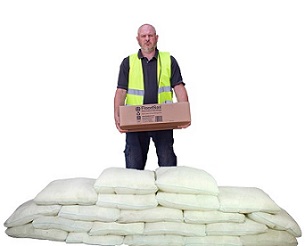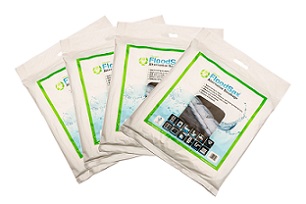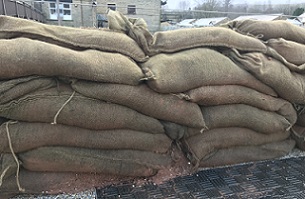 All these 20 FloodSax alternative sandbags came from this one easy-to-carry box
All these 20 FloodSax alternative sandbags came from this one easy-to-carry box
 FloodSax sandless sandbags are easy to store - there are 5 in each bag
FloodSax sandless sandbags are easy to store - there are 5 in each bag
 Sandbags are unwieldy so can be very difficult to build into anti-flood barriers
Sandbags are unwieldy so can be very difficult to build into anti-flood barriers
 FloodSax alternative sandbags are a uniform shape, ideal for building into temporary anti-flood walls and barriers
FloodSax alternative sandbags are a uniform shape, ideal for building into temporary anti-flood walls and barriers
Why one forward-thinking flood action group uses FloodSax alternative sandbags instead of traditional sandbags
A flood action group far prefers FloodSax alternative sandbags to traditional sandbags to protect homes and businesses from flooding.
Tarring Flood Action Group (TFAG) covers the village of Tarring in Worthing, West Sussex and its long history means its ancient buildings need to be protected from flooding.
Tarring was listed in the Domesday Book in 1086 and some of its existing buildings date from the 12th and 14th centuries and lie within the West Tarring Conservation Area.
TFAG first heard about FloodSax through the National Flood Forum, a charity which supports and represents people at risk of flooding throughout the UK.
TFAG team member Robert McCusker said the group is loath to use traditional sandbags as they can cause severe environmental problems if they deteriorate and the sand washes into the drainage system.
Also, volunteers and residents would struggle to fill, store and shift sandbags as they are so heavy and unwieldy.
FloodSax weigh just 13 ounces and resemble a large pillowcase until they are immersed in water. The special gelling polymer inside them absorbs around 20kg of water, transforming the FloodSax into a sandless sandbag in around five minutes. Their uniform shape and size – they measure 52cms by 47cms and are 20cms deep when energised – means they are easy to build into walls and barriers.
A box of 20 FloodSax weighs just 21lbs (9.5kilos) and is 54cms by 50cms by 18cms so can easily be carried by one person. Twenty traditional sandbags would need to be on a pallet and transported using a large van.
Robert said: “Tarring High Street is at the heart of the Conservation Area. The narrowness and impermeability of the street, combined with a Victorian drainage system and urban development at the foot of the South Downs renders the area vulnerable to pluvial flooding in the event of heavy downpours and thunderstorms. When adverse conditions combine, the street can seem like a natural river.”
Tarring has had three serious flood events over the last 20 years and just a few months ago suffered a short yet severe flash flood which breached the flood defences in a small number of cases.
TFAG was formed six years ago and with support from West Sussex County Council’s Operation Watershed they commissioned a study to discover the reasons for surface water flooding in the area and to assess the feasibility of implementing retrofitted Sustainable Drainage Systems to address the problems.
Some of the problems have now been addressed – drains have been high-pressure jet washed and CCTV checked for damage, roadside verges have been converted to raingardens and a large team of Adopt-a-Drain volunteer residents regularly check that drain covers are not blocked with leaves or debris.
But there is still the very real possibility a flood could happen at any time.
Robert said: “The measures we now have in place will help to raise the flood threshold level but properties have been breached by floodwater in the past and in the light of increased risk as a result of climate change we want to do all we can to prevent it from happening again.”
With guidance from The National Flood Forum and information from the Environment Agency and others, TFAG has developed a Community Resilience and Emergency Action Plan to help residents and businesses become more resilient to flooding and to deal with flooding when it does happen.
Robert added “We are encouraging all our residents to be prepared. People still think it won’t happen to them, but flooding can happen to anyone. One thing we can be sure of is that climate change will increase the risk and severity of flooding.
“The National Flood Forum has a number of recommendations to make properties in flood risk areas more flood resilient and one of them was to use sandbag alternatives like FloodSax.”
The group particularly likes the fact that FloodSax are multi-purpose so can be used to prevent flooding both inside and outside properties. Outside, they are made into temporary flood barriers or flood walls while inside, in their dry state they can be popped beneath pipes, under floorboards and in other hard-to-reach places to soak up leaks, drips, spills and internal floods from leaking pipes, radiators, boilers and kitchen sinks.
They can massively reduce the damage until a plumber can get there to fix the problem.
For more information on FloodSax go to http://www.floodsax.co.uk/
To find out more about Tarring Flood Action Group go to https://www.tarringfloodactiongroup.org/